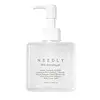What's inside
What's inside
 Key Ingredients
Key Ingredients

No key ingredients
 Benefits
Benefits

 Concerns
Concerns

 Ingredients Side-by-side
Ingredients Side-by-side

Water
Skin ConditioningPotassium Laureth Phosphate
EmulsifyingGlycerin
HumectantButylene Glycol
HumectantPotassium Cocoyl Glutamate
Acrylates/C10-30 Alkyl Acrylate Crosspolymer
Emulsion Stabilising1,2-Hexanediol
Skin ConditioningCaprylyl Glycol
EmollientSodium Cocoyl Glutamate
CleansingSalicylic Acid
MaskingCoco-Glucoside
CleansingPolyglyceryl-10 Laurate
Skin ConditioningSodium Cocoyl Isethionate
CleansingParfum
MaskingSodium Phytate
Quillaja Saponaria Bark Extract
CleansingCitric Acid
BufferingSodium Citrate
BufferingWater, Potassium Laureth Phosphate, Glycerin, Butylene Glycol, Potassium Cocoyl Glutamate, Acrylates/C10-30 Alkyl Acrylate Crosspolymer, 1,2-Hexanediol, Caprylyl Glycol, Sodium Cocoyl Glutamate, Salicylic Acid, Coco-Glucoside, Polyglyceryl-10 Laurate, Sodium Cocoyl Isethionate, Parfum, Sodium Phytate, Quillaja Saponaria Bark Extract, Citric Acid, Sodium Citrate
Water
Skin ConditioningPotassium Laureth Phosphate
EmulsifyingGlycerin
HumectantLauryl Hydroxysultaine
CleansingAcrylates/C10-30 Alkyl Acrylate Crosspolymer
Emulsion StabilisingQuillaja Saponaria Bark Extract
CleansingCentella Asiatica Extract
CleansingHamamelis Virginiana Water
AstringentPotassium Cocoyl Glutamate
Citric Acid
BufferingCoco-Glucoside
CleansingSodium Chloride
MaskingCaprylyl Glycol
EmollientGlyceryl Caprylate
EmollientTromethamine
BufferingSodium Cocoyl Glutamate
CleansingSodium Cocoyl Isethionate
Cleansing1,2-Hexanediol
Skin ConditioningDisodium EDTA
Water, Potassium Laureth Phosphate, Glycerin, Lauryl Hydroxysultaine, Acrylates/C10-30 Alkyl Acrylate Crosspolymer, Quillaja Saponaria Bark Extract, Centella Asiatica Extract, Hamamelis Virginiana Water, Potassium Cocoyl Glutamate, Citric Acid, Coco-Glucoside, Sodium Chloride, Caprylyl Glycol, Glyceryl Caprylate, Tromethamine, Sodium Cocoyl Glutamate, Sodium Cocoyl Isethionate, 1,2-Hexanediol, Disodium EDTA
 Reviews
Reviews

Ingredients Explained
These ingredients are found in both products.
Ingredients higher up in an ingredient list are typically present in a larger amount.
1,2-Hexanediol is a synthetic liquid and another multi-functional powerhouse.
It is a:
- Humectant, drawing moisture into the skin
- Emollient, helping to soften skin
- Solvent, dispersing and stabilizing formulas
- Preservative booster, enhancing the antimicrobial activity of other preservatives
Acrylates/C10-30 Alkyl Acrylate Crosspolymer is a synthetic polymer. It is used to thicken and improve the texture of products. Due to its properties, it can prevent water and oil ingredients from separating.
Caprylyl Glycol is a humectant and emollient, meaning it attracts and preserves moisture.
It is a common ingredient in many products, especially those designed to hydrate skin. The primary benefits are retaining moisture, skin softening, and promoting a healthy skin barrier.
Though Caprylyl Glycol is an alcohol derived from fatty acids, it is not the kind that can dry out skin.
This ingredient is also used as a preservative to extend the life of products. It has slight antimicrobial properties.
Learn more about Caprylyl GlycolCitric Acid is an alpha hydroxy acid (AHA) naturally found in citrus fruits like oranges, lemons, and limes.
Like other AHAs, citric acid can exfoliate skin by breaking down the bonds that hold dead skin cells together. This helps reveal smoother and brighter skin underneath.
However, this exfoliating effect only happens at high concentrations (20%) which can be hard to find in cosmetic products.
Due to this, citric acid is usually included in small amounts as a pH adjuster. This helps keep products slightly more acidic and compatible with skin's natural pH.
In skincare formulas, citric acid can:
While it can provide some skin benefits, research shows lactic acid and glycolic acid are generally more effective and less irritating exfoliants.
Most citric acid used in skincare today is made by fermenting sugars (usually from molasses). This synthetic version is identical to the natural citrus form but easier to stabilize and use in formulations.
Read more about some other popular AHA's here:
Learn more about Citric AcidCoco-Glucoside is a surfactant, or a cleansing ingredient. It is made from glucose and coconut oil.
Surfactants help gather dirt, oil, and other pollutants from your skin to be rinsed away.
This ingredient is considered gentle and non-comedogenic. However, it may still be irritating for some.
Learn more about Coco-GlucosideGlycerin is already naturally found in your skin. It helps moisturize and protect your skin.
A study from 2016 found glycerin to be more effective as a humectant than AHAs and hyaluronic acid.
As a humectant, it helps the skin stay hydrated by pulling moisture to your skin. The low molecular weight of glycerin allows it to pull moisture into the deeper layers of your skin.
Hydrated skin improves your skin barrier; Your skin barrier helps protect against irritants and bacteria.
Glycerin has also been found to have antimicrobial and antiviral properties. Due to these properties, glycerin is often used in wound and burn treatments.
In cosmetics, glycerin is usually derived from plants such as soybean or palm. However, it can also be sourced from animals, such as tallow or animal fat.
This ingredient is organic, colorless, odorless, and non-toxic.
Glycerin is the name for this ingredient in American English. British English uses Glycerol/Glycerine.
Learn more about GlycerinWe don't have a description for Potassium Cocoyl Glutamate yet.
We don't have a description for Potassium Laureth Phosphate yet.
We don't have a description for Quillaja Saponaria Bark Extract yet.
Sodium Cocoyl Glutamate is a gentle cleanser and surfactant. It is the sodium salt of the Cocoyl Glutamic Acid and comes from coconut oil. As a surfactant, it helps lift dirt and oil to be washed away.
Sodium Cocoyl Glutamate also has an emolliating effect and can help leave the skin feeling soft.
Sodium cocoyl isethionate is a natural ingredient from coconut oil. It is an ultra gentle cleanser that gives a nice foam without drying the skin or impacting the skin barrier.
The amount of foam created depends on the amount of sodium cocoyl isethionate used in the product.
This ingredient also helps improve the spreadability of a product.
Learn more about Sodium Cocoyl IsethionateWater. It's the most common cosmetic ingredient of all. You'll usually see it at the top of ingredient lists, meaning that it makes up the largest part of the product.
So why is it so popular? Water most often acts as a solvent - this means that it helps dissolve other ingredients into the formulation.
You'll also recognize water as that liquid we all need to stay alive. If you see this, drink a glass of water. Stay hydrated!
Learn more about Water